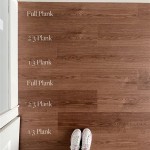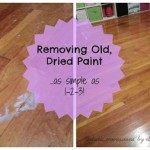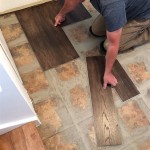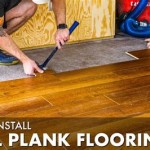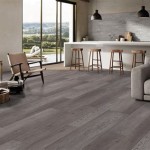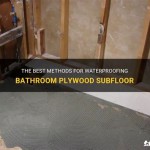How to Remove Sticky Stuff From Wooden Floors
Dealing with sticky residue on wooden floors is a common household challenge. Whether it stems from spilled food, adhesive tape, dropped candy, or other unknown sources, the unsightly presence of sticky patches can detract from the beauty and integrity of the flooring. Effective removal requires a strategic approach that considers the type of adhesive, the finish of the wood, and the potential for damage. This guide provides a comprehensive overview of methods for removing sticky substances from wooden floors without compromising their surface.
Before commencing any cleaning process, identifying the type of wood finish is crucial. Common finishes include polyurethane, varnish, shellac, wax, and oil. Polyurethane finishes are durable and water-resistant, making them more resilient to various cleaning solutions. Waxed or oiled floors, conversely, are more susceptible to damage and require milder cleaning agents. Applying an inappropriate cleaning method can strip the finish, leaving behind a dull or damaged appearance. A small, inconspicuous test patch is always recommended to assess the solution's impact before treating the entire affected area.
Key Point 1: Gathering Essential Supplies and Understanding the Risks
Prior to beginning the cleaning process, assembling the necessary supplies is essential for efficient and effective removal of the sticky residue. Common items to gather include:
- Soft cloths or microfiber towels: These materials are gentle on wood finishes and minimize the risk of scratching.
- Plastic scraper or putty knife: A plastic scraper offers a non-abrasive alternative to metal tools, reducing the potential for damage to the wood surface.
- Warm water: Often, warm water alone is sufficient to loosen certain types of sticky residue.
- Mild dish soap: A small amount of mild dish soap can be added to warm water to enhance its cleaning power.
- White vinegar: Diluted white vinegar is a natural cleaning agent that can effectively dissolve many types of sticky substances.
- Rubbing alcohol (isopropyl alcohol): Isopropyl alcohol is a solvent that can break down adhesives, but it should be used cautiously and sparingly.
- Baking soda: Baking soda can be used as a gentle abrasive cleaner when mixed with water.
- Hair dryer: A hair dryer can be used to warm the sticky residue, making it easier to scrape away.
- Mineral spirits: Mineral spirits are a stronger solvent, suitable for tougher adhesives, but require careful application and adequate ventilation.
- Floor cleaner specifically designed for wood floors: These cleaners are formulated to clean wood floors without damaging the finish.
Understanding the risks associated with each cleaning method is paramount. Abrasive cleaners or tools can scratch or damage the wood finish. Harsh chemicals can strip the finish or discolor the wood. Excessive moisture can warp or damage the wood. Therefore, it is imperative to proceed with caution, test cleaning solutions in an inconspicuous area, and avoid prolonged or excessive exposure of the wood to any cleaning agent.
Furthermore, considering the age and condition of the wooden floor is important. Older floors may have fragile finishes that are more susceptible to damage. Floors with existing damage, such as scratches or dents, may require more gentle cleaning methods to prevent further deterioration.
Key Point 2: Implementing Gradual Cleaning Methods
The most effective approach to removing sticky residue from wooden floors involves starting with the gentlest methods and gradually progressing to more aggressive techniques only if necessary. This minimizes the risk of damaging the floor's finish.
Step 1: Warm Water and Gentle Scraping
Begin by dampening a soft cloth with warm water and gently wiping the sticky area. Allow the warm water to sit on the residue for a few minutes to help loosen it. Then, use a plastic scraper or putty knife to carefully scrape away the softened residue. Avoid applying excessive pressure, as this can scratch the wood surface. Repeat this process as needed until the majority of the sticky substance is removed.
Step 2: Mild Dish Soap Solution
If warm water alone is insufficient, add a small amount of mild dish soap to the warm water to create a cleaning solution. Dampen a clean cloth with the soapy water and gently wipe the sticky area. Again, allow the solution to sit for a few minutes to help loosen the residue. Use the plastic scraper to carefully remove the softened substance. Rinse the area with a clean, damp cloth to remove any soap residue.
Step 3: Diluted White Vinegar Solution
White vinegar is a natural cleaning agent that can effectively dissolve many types of sticky substances. Dilute white vinegar with water in a 1:1 ratio. Dampen a clean cloth with the diluted vinegar solution and gently wipe the sticky area. Allow the solution to sit for a few minutes. Use the plastic scraper to carefully remove the softened residue. Rinse the area with a clean, damp cloth to remove any vinegar residue. Be cautious when using vinegar on waxed floors, as it can potentially strip the wax.
Step 4: Rubbing Alcohol (Isopropyl Alcohol)
Rubbing alcohol is a solvent that can break down adhesives, but it should be used sparingly and with caution. Dampen a clean cloth with rubbing alcohol and gently blot the sticky area. Avoid excessive rubbing, as this can damage the finish. Allow the alcohol to sit for a few seconds to dissolve the residue. Wipe away the dissolved residue with a clean cloth. Ensure the area is well-ventilated when using rubbing alcohol.
Step 5: Baking Soda Paste
Baking soda can be used as a gentle abrasive cleaner. Mix baking soda with a small amount of water to create a paste. Apply the paste to the sticky area and gently rub with a soft cloth. Rinse the area with a clean, damp cloth to remove any baking soda residue. Avoid using excessive pressure, as baking soda can scratch the wood finish.
Step 6: Hair Dryer Application
A hair dryer can be used to warm the sticky residue, making it easier to scrape away. Set the hair dryer to a low heat setting and direct the warm air onto the sticky area. As the residue softens, use a plastic scraper to carefully remove it. Be careful not to overheat the area, as this could damage the wood finish.
Step 7: Specialized Wood Floor Cleaner
If the aforementioned methods prove insufficient, consider using a floor cleaner specifically designed for wood floors. These cleaners are formulated to clean wood floors without damaging the finish. Follow the manufacturer's instructions carefully. Apply the cleaner to the affected area and gently wipe with a soft cloth.
Key Point 3: Advanced Methods and Preventative Measures
For particularly stubborn sticky residue, more advanced methods may be necessary. These methods require even greater caution to avoid damaging the wood floor.
Step 8: Mineral Spirits (Paint Thinner)
Mineral spirits are a stronger solvent suitable for tougher adhesives. However, they should only be used as a last resort due to their potential to damage the finish. Ensure adequate ventilation when using mineral spirits. Dampen a clean cloth with mineral spirits and gently blot the sticky area. Allow the mineral spirits to sit for a few seconds to dissolve the residue. Wipe away the dissolved residue with a clean cloth. Immediately clean the area with a wood floor cleaner to remove any residual mineral spirits. Wear gloves when handling mineral spirits.
Repairing Potential Damage
If the cleaning process results in any damage to the wood floor finish, such as scratches or dullness, repair options may be necessary. Minor scratches can often be buffed out with a fine-grit sandpaper followed by a wood polish. More significant damage may require refinishing the affected area or the entire floor. Consult with a professional flooring contractor for guidance on the best repair options.
Preventative Measures
Preventing sticky residue buildup is the most effective way to maintain the beauty of wooden floors. Employing preventative measures can significantly reduce the frequency and severity of sticky residue problems.
- Use rugs and mats in high-traffic areas and areas prone to spills.
- Clean up spills immediately to prevent them from hardening and becoming sticky.
- Avoid using excessive amounts of adhesive tape on wooden floors. If tape is necessary, use a low-tack adhesive and remove it carefully.
- Regularly sweep or vacuum the floor to remove dust and debris that can contribute to sticky buildup.
- Consider applying a protective finish to the wood floor to enhance its resistance to stains and spills.
By understanding the risks associated with different cleaning methods, implementing gradual cleaning techniques, and employing preventative measures, individuals can effectively remove sticky residue from wooden floors while preserving their beauty and integrity. Consistent and careful maintenance will ensure the longevity and appeal of these valuable surfaces.

How To Remove Glue From Wood Floors Pete S

4 Ways To Remove Adhesive From A Hardwood Floor Wikihow

First Aid Remove Sticky Residue Simple Decorating Tips

4 Ways To Remove Adhesive From A Hardwood Floor Wikihow

How To Remove Sticky Residue From Hardwood Floors

4 Reasons Your Floors Are Sticky And How To Fix Them

4 Ways To Remove Adhesive From A Hardwood Floor Wikihow

First Aid Remove Sticky Residue Simple Decorating Tips

How To Remove Sticky Residue From Hardwood Floors

How To Remove Glue From Wood Floors Pete S
See Also
